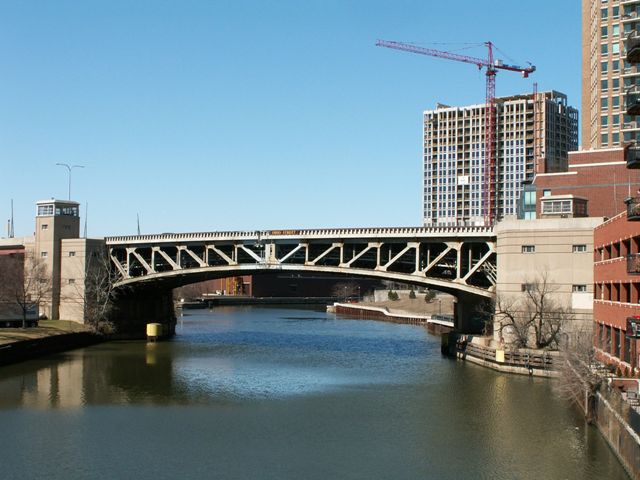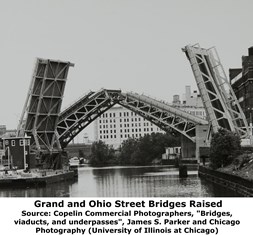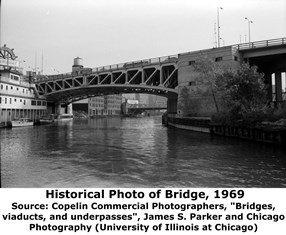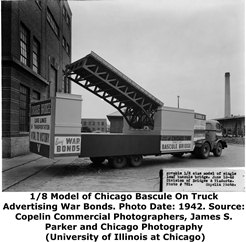We Recommend:
Bach Steel - Experts at historic truss bridge restoration.
BridgeHunter.com Phase 1 is released to the public! - Visit Now
Ohio Street Bridge

Primary Photographer(s): Nathan Holth
Bridge Documented: March 26, 2006, June 26, 2010, and August 15, 2013
Ohio Street (I-90 / I-94 Ramp) Over North Branch Chicago River
Chicago: Cook County, Illinois: United States
Metal Rivet-Connected Pratt Deck Truss, Movable: Double Leaf Bascule (Fixed Trunnion) and Approach Spans: Metal Stringer (Multi-Beam), Fixed
1961 By Builder/Contractor: Unknown and Engineer/Design: City of Chicago
1992
219.2 Feet (66.8 Meters)
367.0 Feet (111.9 Meters)
76 Feet (23.16 Meters)
1 Main Span(s) and 2 Approach Span(s)
16020226650

View Information About HSR Ratings
Bridge Documentation
View Archived National Bridge Inventory Report - Has Additional Details and Evaluation
This bridge is one of the few bascule bridges in Chicago that is a true deck truss. In the construction of deck truss bridges, the city more frequently preferred to raise the truss up slightly so that the top chord was above the deck functioning as a guardrail and increasing the vertical clearance under the bridge. That was not done with this bridge, so it stands out as uncommon in the city. Although the bridge was built in 1960 and is one of the younger bascule bridges in Chicago, its trusses are still composed in the traditional manner that the city used for decades including use of rivets and built-up beams with lattice. This is of interest because the trend nationally by 1960 was to switch to rolled beams, eliminate use of lattice and v-lacing, and use bolts instead of rivets. Chicago however seemed to follow its own path, perhaps not seeing a need to change when the tried and true construction methods had served them so well with so many bridges.
Adam Kerman provided the following information:
The Ohio Street bridge over the north branch of the Chicago River was built as part of the Kennedy Expressway construction in the late 1950s, most of which opened in 1960. It's part of a feeder from Wells Street, three lanes in each direction (getting rid of shoulders during a reconstruction). Note that the expressway feeder is immediately north of the original alignment of Ohio Street, which never had a bridge at this point that I know of. Erie Street, nearby, did have a bridge but it was removed years ago. I never saw it. A swath of mostly industrial buildings were demolished between Ohio and Ontario Streets to build the feeder.

Photo Credit: Patrick Hynes
Above: This historical photo shows a 1/8 scale model of a single bascule leaf similar to one of the four individual leaves of the Ohio Street Bridge. The model was created in 1942 and appears to have been part of a unique promotional effort to sell war bonds during World War II. While the model significantly predates the Ohio Street Bridge, it is not known which bridge (if any) that model was specifically built to look like, however the Ohio Street Bridge's leaves are one of the most similar structures to this model.
|
Main Plaque (Numbers May Be Inaccurate, Transcribed
From Google Street View) |
![]()
Historic Bridges of Chicago and Cook County


Chicago and Cook County are home to one of the largest collections of historic bridges in the country, and no other city in the world has more movable bridges. HistoricBridges.org is proud to offer the most extensive coverage of historic Chicago bridges on the Internet.
General Chicago / Cook County Bridge Resources
Chicago's Bridges - By Nathan Holth, author of HistoricBridges.org, this book provides a discussion of the history of Chicago's movable bridges, and includes a virtual tour discussing all movable bridges remaining in Chicago today. Despite this broad coverage, the book is presented in a compact format that is easy to take with you and carry around for reference on a visit to Chicago. The book includes dozens of full color photos. Only $9.95 U.S! ($11.95 Canadian). Order on Amazon.
Chicago River Bridges - By Patrick T. McBriarty, this is a great companion to Holth's book shown above. This much larger book offers an extremely in-depth exploration of Chicago's movable highway bridges, including many crossings that have not existed for many years. Order Now Direct From The Publisher! or order on Amazon.
View Historic American Engineering Record (HAER) Overview of Chicago Bascule Bridges (HAER Data Pages, PDF)
Chicago Loop Bridges - Chicago Loop Bridges is another website on the Internet that is a great companion to the HistoricBridges.org coverage of the 18 movable bridges within the Chicago Loop. This website includes additional information such as connections to popular culture, overview discussions and essays about Chicago's movable bridges, additional videos, and current news and events relating to the bridges.
Additional Online Articles and Resources - This page is a large gathering of interesting articles and resources that HistoricBridges.org has uncovered during research, but which were not specific to a particular bridge listing.
![]()
Photo Galleries and Videos: Ohio Street Bridge
Bridge Photo-Documentation
Original / Full Size PhotosA collection of overview and detail photos. This gallery offers photos in the highest available resolution and file size in a touch-friendly popup viewer.
Alternatively, Browse Without Using Viewer
![]()
Bridge Photo-Documentation
Mobile Optimized PhotosA collection of overview and detail photos. This gallery features data-friendly, fast-loading photos in a touch-friendly popup viewer.
Alternatively, Browse Without Using Viewer
![]()
Maps and Links: Ohio Street Bridge
Coordinates (Latitude, Longitude):
Search For Additional Bridge Listings:
Bridgehunter.com: View listed bridges within 0.5 miles (0.8 kilometers) of this bridge.
Bridgehunter.com: View listed bridges within 10 miles (16 kilometers) of this bridge.
Additional Maps:
Google Streetview (If Available)
GeoHack (Additional Links and Coordinates)
Apple Maps (Via DuckDuckGo Search)
Apple Maps (Apple devices only)
Android: Open Location In Your Map or GPS App
Flickr Gallery (Find Nearby Photos)
Wikimedia Commons (Find Nearby Photos)
Directions Via Sygic For Android
Directions Via Sygic For iOS and Android Dolphin Browser
USGS National Map (United States Only)
Historical USGS Topo Maps (United States Only)
Historic Aerials (United States Only)
CalTopo Maps (United States Only)




